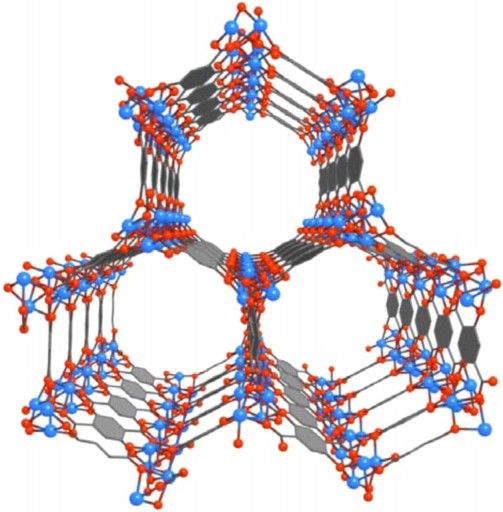Berkeley Lab scientists record first inside look at carbon-capture molecular structure
November 26, 2013
[+]
Researchers with Lawrence Berkeley National Laboratory (Berkeley Lab) have recorded the first electronic structure observations of the adsorption of carbon dioxide inside a metal-organic framework (MOF).
Mg-MOF-74
is a metal-organic framework (MOF) whose porous crystalline structure
could enable it to serve as a storage vessel for capturing and
containing the carbon dioxide emitted from coal-burning power plants
(credit: National Academy of Sciences)
The “Mg-MOF-74″ MOF’s porous crystalline structure could enable it to serve as a storage vessel for capturing and containing the carbon dioxide emitted from coal-burning power plants.
MOFs are molecular systems consisting of a metal oxide center surrounded by organic “linker” molecules that form a highly porous three-dimensional crystal framework.
This microporous crystal structure enables MOFs to serve as storage vessels with a sponge-like capacity for capturing and containing carbon dioxide, thought to be one of the primary greenhouse gases responsible for exacerbating global climate change.
When a solvent molecule applied during the formation of the MOF is subsequently removed, the result is an unsaturated “open” metal site MOF that has a strong affinity for carbon dioxide.
Working at Berkeley Lab’s Advanced Light Source (ALS), a team led by Jeff Kortright of Berkeley Lab’s Materials Sciences Division used the X-ray spectroscopy technique known as Near Edge X-ray Absorption Fine Structure (NEXAFS) to obtain what are believed to be the first ever measurements of chemical and electronic signatures inside of a MOF during gas adsorption.
[+]
“Open metal site MOFs preferentially adsorb carbon dioxide over
nitrogen or methane due to carbon dioxide’s larger quadrupole moment and
greater polarizability,” Kortright says. “Mg-MOF-74 with its unique
pyramidal geometry is especially selective for carbon dioxide over other
greenhouse gases and has an exceptionally large storage capacity.”
Advanced Light Source (credit: Berkeley Lab)
Support for this work was provided by the Center for Gas Separations Relevant to Clean Energy Technologies, an Energy Frontier Research Center funded by the DOE Office of Science.
Abstract of Journal of the American Chemical Society paper
We explore the local electronic signatures of molecular adsorption at coordinatively unsaturated binding sites in the metal–organic framework Mg-MOF-74 using X-ray spectroscopy and first-principles calculations. In situ measurements at the Mg K-edge reveal distinct pre-edge absorption features associated with the unique, open coordination of the Mg sites which are suppressed upon adsorption of CO2 and N,N′-dimethylformamide. Density functional theory shows that these spectral changes arise from modifications of local symmetry around the Mg sites upon gas uptake and are strongly dependent on the metal–adsorbate binding strength. The expanded MOF Mg2(dobpdc) displays the same behavior upon adsorption of CO2 and N,N′-dimethylethylenediamine. Similar sensitivity to local symmetry is expected for any open metal site, making X-ray spectroscopy an ideal tool for examining adsorption in such MOFs. Qualitative agreement between ambient-temperature experimental and 0 K theoretical spectra is good, with minor discrepancies thought to result from framework vibrational motion.
(¯`*• Global Source and/or more resources at http://goo.gl/zvSV7 │ www.Future-Observatory.blogspot.com and on LinkeIn Group's "Becoming Aware of the Futures" at http://goo.gl/8qKBbK │ @SciCzar │ Point of Contact: www.linkedin.com/in/AndresAgostini
 Washington
Washington